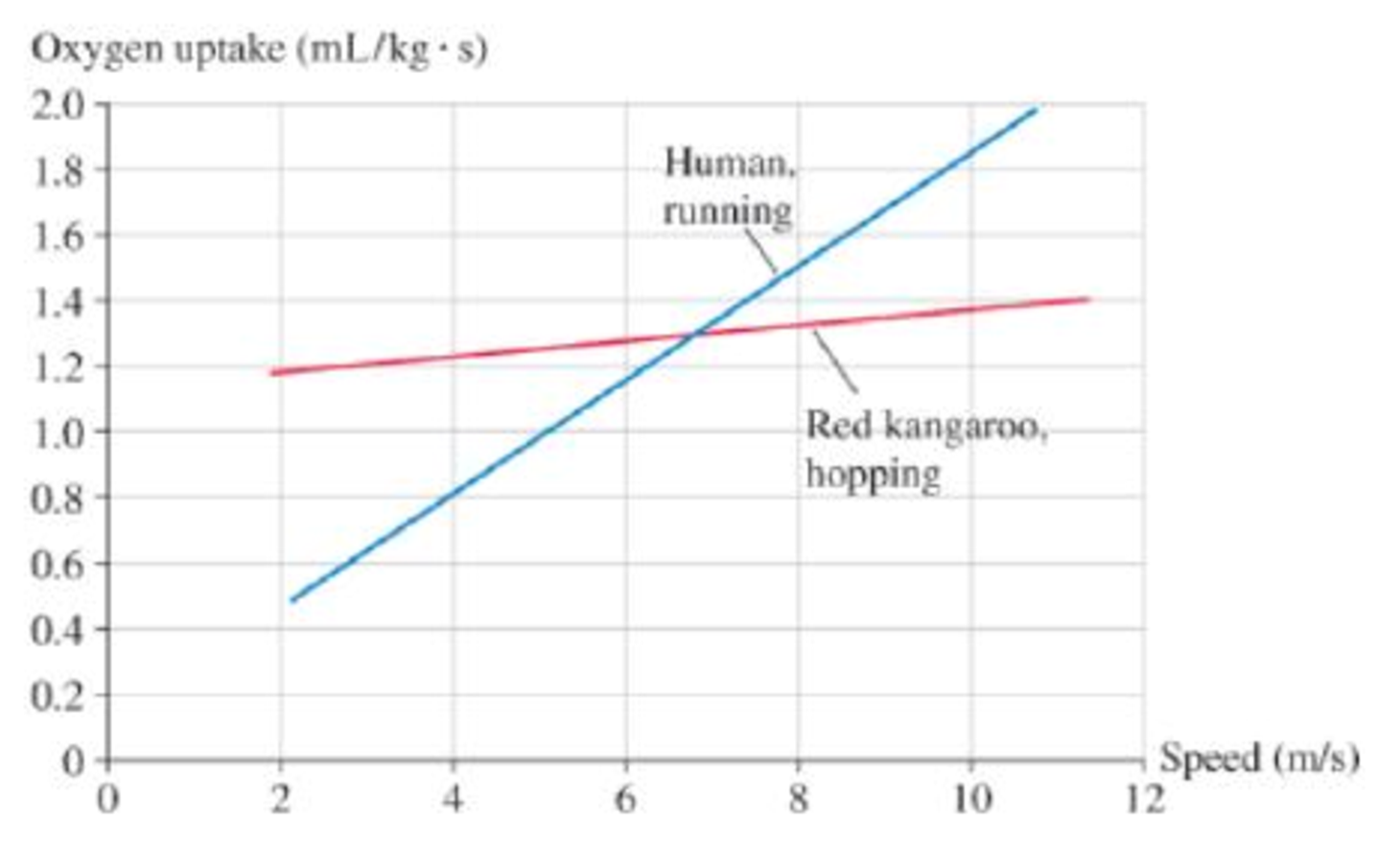
Concept explainers
MCAT-Style Passage Problems
Kangaroo Locomotion

Kangaroos have very stout tendons in their legs that can be used to store energy. When a kangaroo lands on its feet, the tendons stretch, transforming kinetic energy of motion to elastic potential energy. Much of this energy can be transformed back into kinetic energy as the kangaroo takes another hop. The kangaroo’s peculiar hopping gait is not very efficient at low speeds but is quite efficient at high speeds.
Figure P11.68 shows the energy cost of human and kangaroo locomotion. The graph shows oxygen uptake (in mL/s) per kg of body mass, allowing a direct comparison between the two species.
Figure P11.68 Oxygen uptake (a measure of energy use per second) for a running human and a hopping kangaroo.

For humans, the energy used per second (i.e., power) is proportional to the speed. That is, the human curve nearly passes through the origin, so running twice as fast takes approximately twice as much power. For a hopping kangaroo, the graph of energy use has only a very small slope. In other words, the energy used per second changes very little with speed. Going faster requires very little additional power. Treadmill tests on kangaroos and observations in the wild have shown that they do not become winded at any speed at which they are able to hop. No matter how fast they hop, the necessary power is approximately the same.
At a speed of 4 m/s,
A. A running human is more efficient than an equal-mass hopping kangaroo.
B. A running human is less efficient than an equal-mass hopping kangaroo.
C. A running human and an equal-mass hopping kangaroo have about the same efficiency.
Want to see the full answer?
Check out a sample textbook solution
Chapter 11 Solutions
College Physics: A Strategic Approach (3rd Edition)
Additional Science Textbook Solutions
Essential University Physics: Volume 1 (3rd Edition)
Essential University Physics: Volume 2 (3rd Edition)
Conceptual Integrated Science
Modern Physics
Physics for Scientists and Engineers: A Strategic Approach, Vol. 1 (Chs 1-21) (4th Edition)
Cosmic Perspective Fundamentals
- A student has the idea that the total work done on an object is equal to its final kinetic energy. Is this idea true always, sometimes, or never? Ii it is sometimes true, under what circumstances? If it is always or never true, explain why.arrow_forwardIf you run down some stairs and stop, what happens to your kinetic energy and your initial gravitational potential energy?arrow_forward(a) How fast must a 3000-kg elephant move to have the same kinetic energy as a 65.0-kg sprinter running at 10.0 m/s? (b) Discuss how the larger energies needed for the movement of larger animals would relate to metabolic rates.arrow_forward
- (a) Calculate the work done on a 1500-kg elevator car by its cable to lift it 40.0 m at constant speed, assuming friction averages 100 N. (b) What is the work done on the lift by the gravitational force in this process? (c) What is the total work done on the lift?arrow_forward(a) What is the efficiency of an out-of-condition professor who does 2.10105J of useful work while metabolizing 500 kcal of food energy? (b) How many food calories would a well-conditioned athlete metabolize in doing the same work with an efficiency of 20%?arrow_forward. The fastest that a human has run is about 12 m/s. (a) If a pole vaulter could run this fast and convert all of her kinetic energy into gravitational potential energy, how high would she go? (b) Compare this height with the world record in the pole vault.arrow_forward
- In Chapter 7, the work-kinetic energy theorem, W = K, was introduced. This equation states that work done on a system appears as a change in kinetic energy. It is a special-case equation, valid if there are no changes in any other type of energy such as potential or internal. Give two or three examples in which work is done on a system but the change in energy of the system is not a change in kinetic energy.arrow_forward(a) Calculate the energy in kJ used by a 55.0-kg woman who does 50 deep knee bends in which her center of mass is lowered and raised 0.400 m. (She does work in both directions.) You may assume her efficiency is 20%. (b) What is the average power consumption rate in watts if she does this in 3.00 min?arrow_forwardIntegrated Concepts (a) What force must be supplied by an elevator cable to produce an acceleration of 0.800 m/s2 against a 200-N frictional force, if the mass of the loaded elevator is 1500 kg? (b) How much work is done by the cable in lifting the elevator 20.0 m? (c) What is the final speed of the elevator if it starts from rest? (d) How much work went into thermal energy?arrow_forward
- What does work on a shuffleboard puck as it slides to rest? Why is the board dusted, and how does this affect work?arrow_forwardThe chin-up is one exercise that can be used to strengthen the biceps muscle. This muscle can exert a force of approximately 8.00 102 N as it contracts a distance of 7.5 cm in a 75-kg male.3 (a) How much work can the biceps muscles (one in each arm) perform in a single contraction? (b) Compare this amount of work with the energy required to lift a 75-kg person 40. cm in performing a chin-up. (c) Do you think the biceps muscle is the only muscle involved in performing a chin-up?arrow_forwardIgnoring details associated with friction, extra forces exerted by arm and leg muscles, and other factors, we can consider a pole vault as the conversion of an athlete’s running kinetic energy to gravitational potential energy. If an athlete is to lift his body 4.8 m during a vault, what speed must he have when he plants his pole?arrow_forward
 College PhysicsPhysicsISBN:9781938168000Author:Paul Peter Urone, Roger HinrichsPublisher:OpenStax College
College PhysicsPhysicsISBN:9781938168000Author:Paul Peter Urone, Roger HinrichsPublisher:OpenStax College Principles of Physics: A Calculus-Based TextPhysicsISBN:9781133104261Author:Raymond A. Serway, John W. JewettPublisher:Cengage Learning
Principles of Physics: A Calculus-Based TextPhysicsISBN:9781133104261Author:Raymond A. Serway, John W. JewettPublisher:Cengage Learning Physics for Scientists and Engineers with Modern ...PhysicsISBN:9781337553292Author:Raymond A. Serway, John W. JewettPublisher:Cengage Learning
Physics for Scientists and Engineers with Modern ...PhysicsISBN:9781337553292Author:Raymond A. Serway, John W. JewettPublisher:Cengage Learning Physics for Scientists and EngineersPhysicsISBN:9781337553278Author:Raymond A. Serway, John W. JewettPublisher:Cengage Learning
Physics for Scientists and EngineersPhysicsISBN:9781337553278Author:Raymond A. Serway, John W. JewettPublisher:Cengage Learning College PhysicsPhysicsISBN:9781305952300Author:Raymond A. Serway, Chris VuillePublisher:Cengage Learning
College PhysicsPhysicsISBN:9781305952300Author:Raymond A. Serway, Chris VuillePublisher:Cengage Learning College PhysicsPhysicsISBN:9781285737027Author:Raymond A. Serway, Chris VuillePublisher:Cengage Learning
College PhysicsPhysicsISBN:9781285737027Author:Raymond A. Serway, Chris VuillePublisher:Cengage Learning





